- Joined
- Jun 25, 2012
- Messages
- 4,429
A trip report from another country, and another activity (not Hiking and Camping) and both place and activity are different than my usual.
This climb was conducted during our recent trip to Northern Italy for which I have condensed documentation in this thread. Many people have asked about this via ferrata gig so I thought I would post a TR of one of our climbs, the Piz da Cir V. This climb is rated 2B which is an easy rating. Via ferratas (translated as the iron way) are equipped routes with fixed gear left mostly from historical times, namely WWI and maintained by the Italian climbing clubs for locals and tourists alike. These routes are equipped with protection and aids, such as ladders, bridges and cables, originally intended to aid the soldiers in carrying their little guns, big guns and ammunition to near the tops of the peaks and towers in order to blast the pesky Austrians occupying the homeland.
I have been smitten by the Dolomites for many years and these sheer, craggy towers occupy my dreams and plans. This particular destination in the Sella group have been on my tic list for a long time and were ones we targeted and failed to climb in our 2002 trip to the same mountain range in which we were hit by a sudden storm pattern which sent us packing from the highlands to comfort in Tuscany way back when
Better weather this go around, and some of the same group from that ill-fated trip in 2002 led to a summit on Piz da Cir V!
A view from the approach hike of the surroundings. See what I mean. Grand!
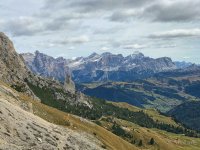
A view of the Piz or peak or tower that we had set our sights on, from below.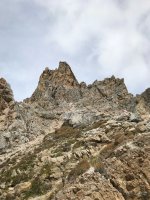
Gearing up at the bottom. Via ferrata, being a very specialized form of climbing requires very specialized gear. That is, a via ferrata lanyard, helmet, gloves and climbing shoes. My friend Dan and his wife donning their gear. Dan and I were on the 2002 trip. I have been climbing and chasing him around for almost 30 years.
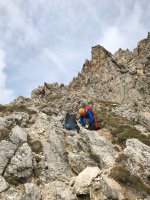
Hamboning it up as we start.
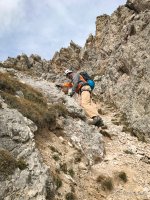
Another view of the route as we start up.
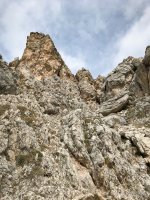
This rock is called Dolomite and it is very similar to limestone. Especially with regards to its coarseness and feature-laden composition. Feature-laden to a climber means a lot of foot and handholds. This is typically very easy climbing for someone used to the more vertical world. Look closely and you can see people high on the route.
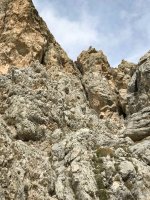
A view looking down a gully mid-route. Much of the ridge is composed of loose rock and talus being shed from the towers.
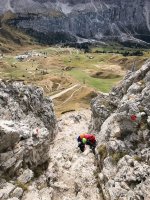
A view of parties ahead of us. Here you can see some of these iron bits. Steel cables that are in place for you to clip into for safety and climbing assists.
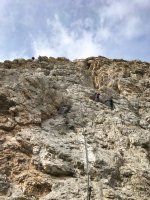
Another view of climbers above. A big reason why we wear helmets. People drop stuff. People knock off rocks.
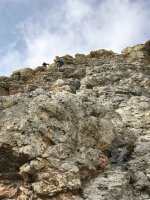
A view of the main Sella group across the mini valley. Every flat-ish area between peaks and ridges is covered in grazing meadow, ski resort, small town or some other type of development. True wilderness, unlike Utah, is few and far in between.
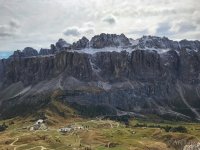
Sella
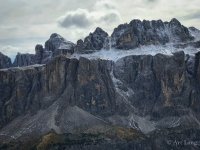
A view looking down the route as we ascend.
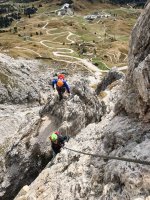
Another... Notice the guy with the green lid.
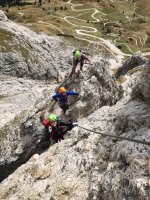
The guy with the green lid was a bit of a strange duck. He latched on to us and followed us around most of the climb and descent. He was a nice enough guy, I suppose, but couldn't speak english and he was certain that the louder he spoke German the more we would be able to understand him. I am pretty sure he couldn't see well at all and was glad to trail us to help lead him. An eccentric in manner and appearance.
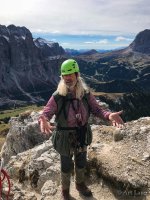
Climb ON!
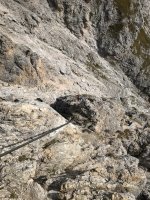
The view to the east and a prototypical small Italian mountain town in the distance.,
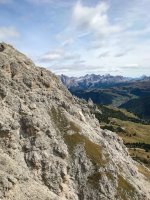
Some sections of the climb were more like hiking, but with exposure.
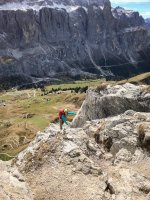
We are now able to start peaking around to the other side of the Piz. Towers and craggy peaks abound. My fave.
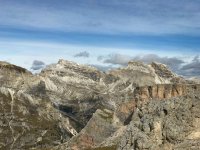
An alpine chough hovering above the summit.
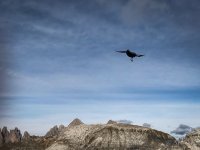
Another chough encounter from the middle of the cliff. This corvid is not from around here, north america that, is but is related to my old pal Corvus corax. I normally don't like to feed the birds but wanted his picture.
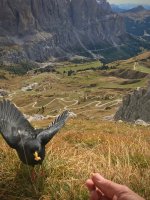
The requisite cross on a sub-summit. Everything had crosses on it. Kind of morbid I guess, but tradition.
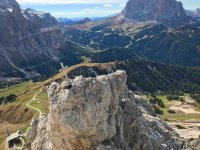
Approaching the top - a view off to the distant peaks.
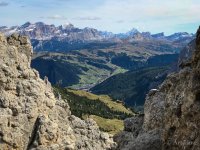
Approaching the tip of the top. The competition on the small tower summit.
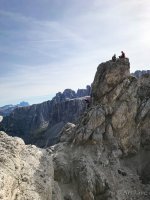
A close up of my friends as they climb the final bit. This was the second crux of the route.
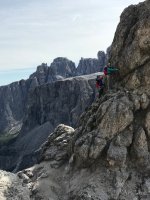
It was a very enjoyable climb and this was only the beginning. After three of four via ferrat we left the mountains and moved on for another couple of weeks for serious eating and drinking You can see a condensed chronicle of the whole three week trip in this trip report.
And that is all. Arrivederci! Any questions?
This climb was conducted during our recent trip to Northern Italy for which I have condensed documentation in this thread. Many people have asked about this via ferrata gig so I thought I would post a TR of one of our climbs, the Piz da Cir V. This climb is rated 2B which is an easy rating. Via ferratas (translated as the iron way) are equipped routes with fixed gear left mostly from historical times, namely WWI and maintained by the Italian climbing clubs for locals and tourists alike. These routes are equipped with protection and aids, such as ladders, bridges and cables, originally intended to aid the soldiers in carrying their little guns, big guns and ammunition to near the tops of the peaks and towers in order to blast the pesky Austrians occupying the homeland.
I have been smitten by the Dolomites for many years and these sheer, craggy towers occupy my dreams and plans. This particular destination in the Sella group have been on my tic list for a long time and were ones we targeted and failed to climb in our 2002 trip to the same mountain range in which we were hit by a sudden storm pattern which sent us packing from the highlands to comfort in Tuscany way back when
Better weather this go around, and some of the same group from that ill-fated trip in 2002 led to a summit on Piz da Cir V!
A view from the approach hike of the surroundings. See what I mean. Grand!

A view of the Piz or peak or tower that we had set our sights on, from below.

Gearing up at the bottom. Via ferrata, being a very specialized form of climbing requires very specialized gear. That is, a via ferrata lanyard, helmet, gloves and climbing shoes. My friend Dan and his wife donning their gear. Dan and I were on the 2002 trip. I have been climbing and chasing him around for almost 30 years.

Hamboning it up as we start.

Another view of the route as we start up.

This rock is called Dolomite and it is very similar to limestone. Especially with regards to its coarseness and feature-laden composition. Feature-laden to a climber means a lot of foot and handholds. This is typically very easy climbing for someone used to the more vertical world. Look closely and you can see people high on the route.

A view looking down a gully mid-route. Much of the ridge is composed of loose rock and talus being shed from the towers.

A view of parties ahead of us. Here you can see some of these iron bits. Steel cables that are in place for you to clip into for safety and climbing assists.

Another view of climbers above. A big reason why we wear helmets. People drop stuff. People knock off rocks.

A view of the main Sella group across the mini valley. Every flat-ish area between peaks and ridges is covered in grazing meadow, ski resort, small town or some other type of development. True wilderness, unlike Utah, is few and far in between.

Sella

A view looking down the route as we ascend.

Another... Notice the guy with the green lid.

The guy with the green lid was a bit of a strange duck. He latched on to us and followed us around most of the climb and descent. He was a nice enough guy, I suppose, but couldn't speak english and he was certain that the louder he spoke German the more we would be able to understand him. I am pretty sure he couldn't see well at all and was glad to trail us to help lead him. An eccentric in manner and appearance.

Climb ON!

The view to the east and a prototypical small Italian mountain town in the distance.,

Some sections of the climb were more like hiking, but with exposure.

We are now able to start peaking around to the other side of the Piz. Towers and craggy peaks abound. My fave.

An alpine chough hovering above the summit.

Another chough encounter from the middle of the cliff. This corvid is not from around here, north america that, is but is related to my old pal Corvus corax. I normally don't like to feed the birds but wanted his picture.

The requisite cross on a sub-summit. Everything had crosses on it. Kind of morbid I guess, but tradition.

Approaching the top - a view off to the distant peaks.

Approaching the tip of the top. The competition on the small tower summit.

A close up of my friends as they climb the final bit. This was the second crux of the route.

It was a very enjoyable climb and this was only the beginning. After three of four via ferrat we left the mountains and moved on for another couple of weeks for serious eating and drinking You can see a condensed chronicle of the whole three week trip in this trip report.
And that is all. Arrivederci! Any questions?
Last edited:
